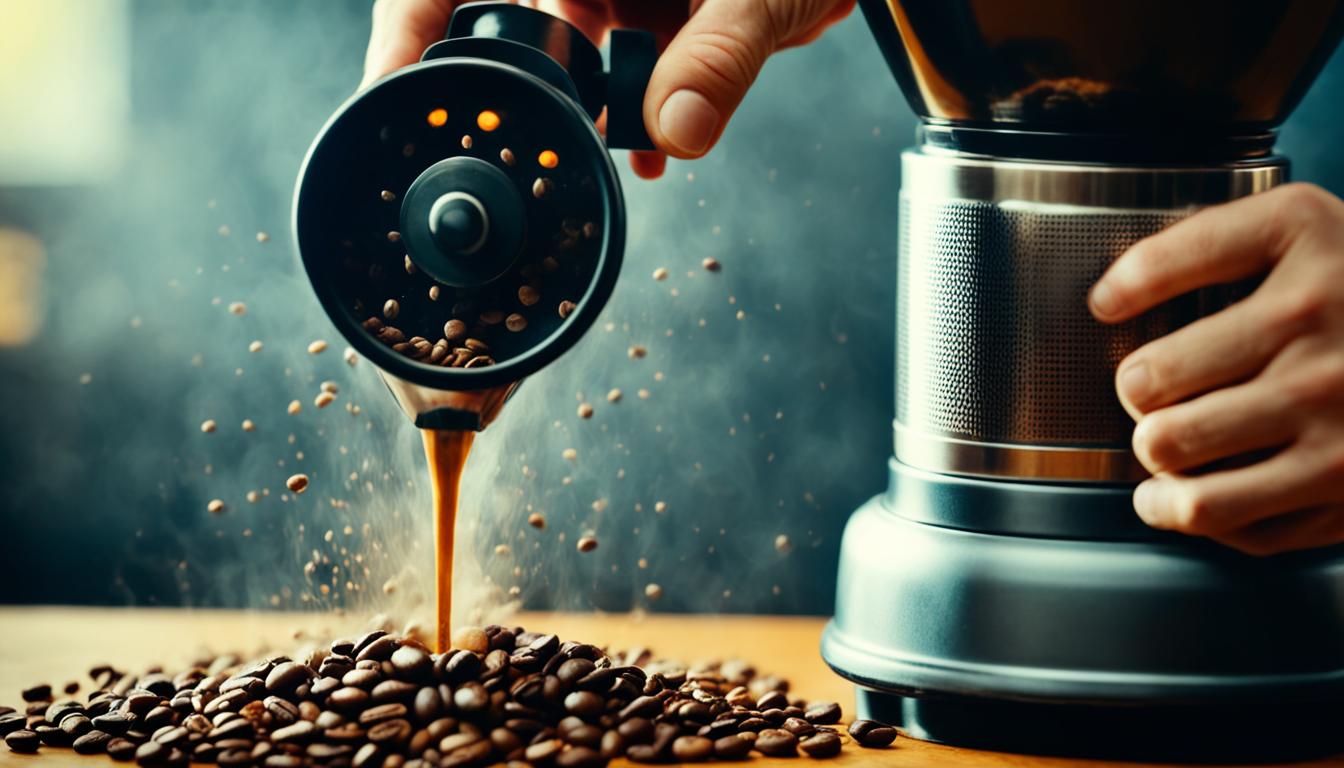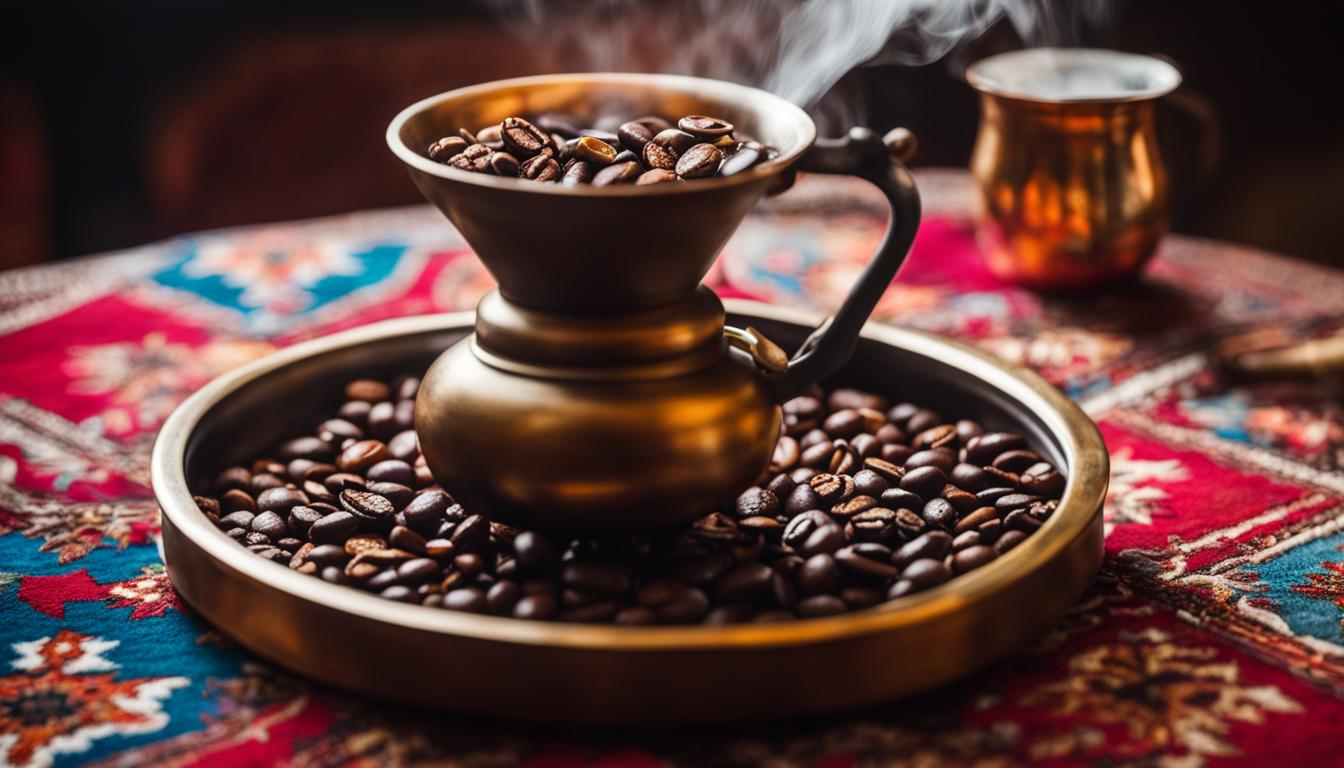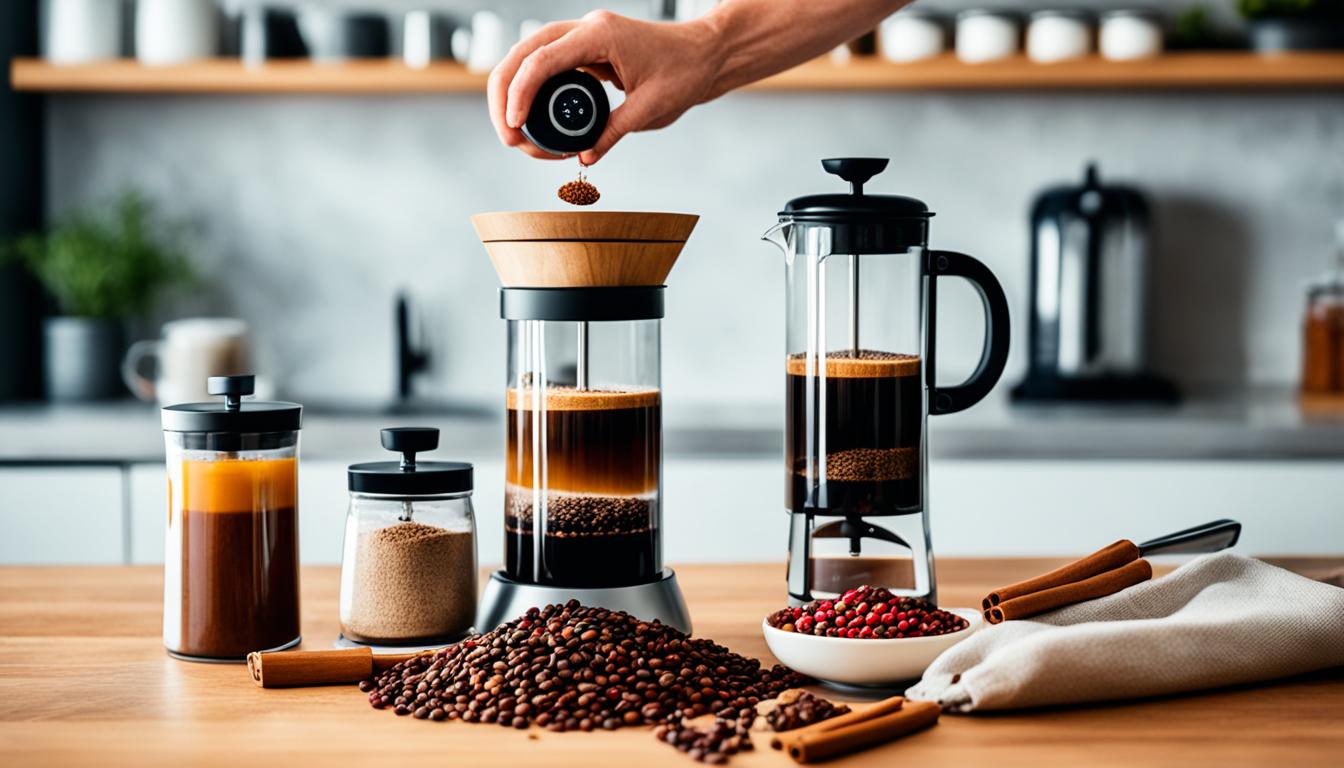Welcome to our guide on grinding coffee for brewing, where we’ll share expert tips and techniques to help you achieve the perfect cup. We all know that coffee is more than just a beverage; it’s an experience. And the journey to that perfect cup starts with the grind.
Grinding coffee beans to the right size is crucial for unlocking the full flavor and aroma of your coffee. It’s not just about grinding; it’s about understanding the different grind sizes and how they impact the brewing process. With the right knowledge and techniques, you can elevate your coffee brewing game to new heights.
Whether you prefer your coffee bold and strong or smooth and mellow, mastering the art of grinding will help you achieve the flavor profile you desire. We’ll cover everything from grinding techniques to the best brewing methods for each grind size. So grab your favorite mug, and let’s dive in!
Key Takeaways:
- Choosing the right grind size is essential for a balanced, flavorful cup of coffee.
- Different brewing methods require specific grind sizes, from coarse to extra fine.
- A consistent grind size allows for optimal coffee extraction and flavor.
- Properly storing coffee beans helps maintain freshness and quality.
- When it comes to coffee grinders, burr grinders offer more control over the grind size and preserve the coffee’s flavor.
Understanding Coffee Grind Size
The size of the coffee grind affects the flavor and strength of the coffee. A finer grind results in a stronger cup of coffee, with more surface area exposed to water for better extraction. A coarser grind produces a weaker cup of coffee, as there is less surface area for water interaction. Different brewing methods require different coffee grind sizes, and understanding these sizes is crucial for brewing the perfect cup.
When it comes to coffee, the grind size plays a significant role in achieving the desired flavor profile. By adjusting the grind size, you can control the extraction process and tailor the taste of your cup of coffee to your liking.
Coffee Grind Sizes for Different Brewing Methods
When it comes to brewing coffee, the grind size plays a crucial role in achieving the perfect flavor and quality in every cup. Different brewing methods require specific coffee grind sizes to ensure optimal extraction and a satisfying brew. Let’s explore the recommended grind sizes for popular brewing methods:
French Press Grind
For those who enjoy the rich and bold flavors of French Press coffee, a coarse grind is recommended. The large particles allow for a longer extraction time, resulting in a full-bodied cup of coffee with a noticeable depth of flavor.
Drip Coffee Grind
Drip coffee makers are a common choice for many coffee lovers, offering convenience and versatility. To achieve the best results with a drip coffee maker, a medium grind is ideal. This grind size allows for a balanced extraction, producing a flavorful and well-rounded cup of coffee.
Pour Over Grind
Pour over brewing methods, such as the V60 or Chemex, offer a more hands-on approach to coffee brewing. Depending on personal preference, the grind size for pour over brewing can range from medium-coarse to medium-fine. A medium-coarse grind is suitable for those who prefer a bolder and more pronounced flavor, while a medium-fine grind brings out a delicate, nuanced flavor profile.
Espresso Grind
Espresso is known for its intense and concentrated flavor, achieved through a quick and focused extraction process. To prepare espresso, a fine grind size is necessary. The fine particles allow for rapid water flow through the coffee grounds, resulting in a strong and flavorful shot of espresso.
Cold Brew Grind
For those hot summer days or a refreshing alternative to hot coffee, cold brew is a popular choice. Cold brew requires a longer steeping time to extract the flavors from the coffee grounds. To achieve the best results, an extra coarse grind is recommended. The large particles enable a slow extraction process, resulting in a smooth, low-acidity brew that is perfect for serving over ice.
By adapting the coffee grind size to the brewing method, you can unlock the full potential of your coffee beans and enjoy a truly exceptional cup of coffee every time.
| Brewing Method | Grind Size |
|---|---|
| French Press | Coarse |
| Drip Coffee | Medium |
| Pour Over | Medium-coarse to Medium-fine |
| Espresso | Fine |
| Cold Brew | Extra coarse |
How to Grind Coffee Beans
When it comes to grinding coffee beans, there are two main types of grinders: blade grinders and burr grinders. Let’s explore the differences and why grinding consistency and techniques matter for the perfect cup of coffee.
The Blade Grinder
The blade grinder is a popular choice among coffee enthusiasts due to its affordability and versatility. It features a spinning blade that chops the beans into smaller pieces. However, one downside of using a blade grinder is that it produces inconsistent grind sizes. This inconsistency can result in uneven extraction and affect the overall taste of your coffee.
“Blade grinders are more affordable but produce inconsistent grind sizes.”
The Burr Grinder
If you’re serious about your coffee brewing, investing in a burr grinder is highly recommended. Although they come at a higher price point, burr grinders offer several advantages over blade grinders. Instead of chopping the beans, burr grinders crush them between two abrasive surfaces, resulting in a more uniform grind size. This consistency leads to better extraction and a more flavorful cup of coffee.
“Burr grinders offer consistent grind sizes and more control over the grind.”
Grinding Techniques
The techniques for grinding coffee beans vary depending on the type of grinder used. Regardless of the grinder, it is generally recommended to grind the coffee beans just before brewing to ensure the freshest flavor. This helps to preserve the aromatic oils and flavors within the beans.
For blade grinders, it is best to use short bursts of grinding instead of continuous grinding. This allows for more control over the grind size and helps prevent overheating. With burr grinders, you can adjust the grind size settings to achieve the desired coarseness or fineness.
To summarize, achieving a consistent grind is crucial for a good extraction and ultimately, the perfect cup of coffee. While blade grinders may be more affordable, burr grinders offer better grind consistency and control. No matter which grinder you choose, grinding your coffee beans just before brewing will ensure the freshest and most flavorful cup.
Table: Blade Grinders vs. Burr Grinders
| Blade Grinders | Burr Grinders |
|---|---|
| Produce inconsistent grind sizes | Offer consistent grind sizes |
| More affordable | Higher price point |
| Versatile | More control over the grind |
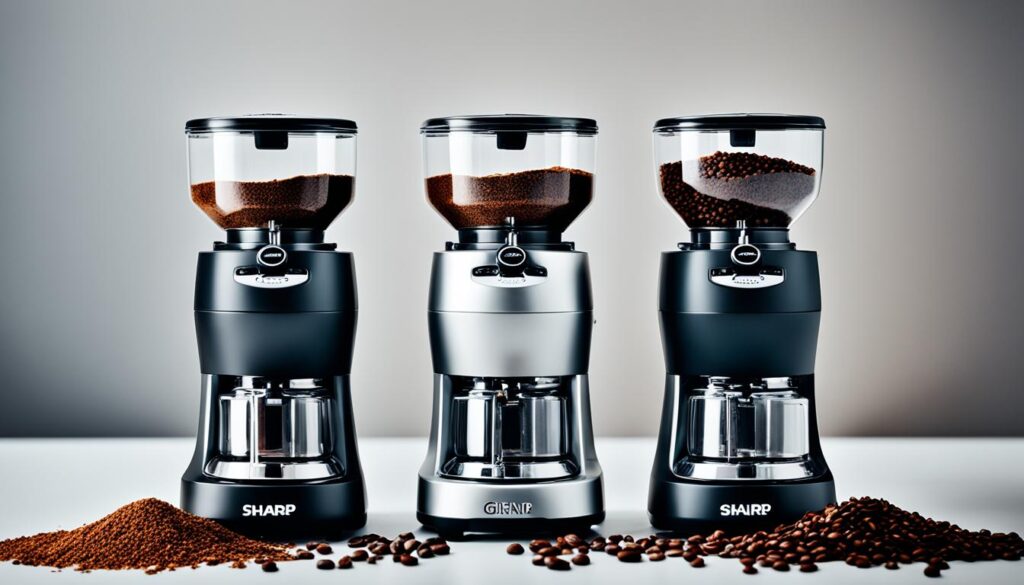
Next, in Section 5, we will explore the best practices for storing coffee beans to maintain their freshness and flavor.
Storing Coffee Beans
Properly storing coffee beans is essential for preserving their freshness and flavor. To ensure that your coffee beans stay at their best, follow these simple storage guidelines:
- Use an Airtight Container: Store your coffee beans in an airtight container to protect them from exposure to oxygen, which can cause them to go stale. A glass or ceramic container with a sealable lid is an excellent choice for preserving freshness.
- Keep Away from Heat: Avoid storing coffee beans near sources of heat, such as the stovetop or direct sunlight. Heat can accelerate the deterioration process and negatively affect the flavor of the coffee.
- Protect from Light: UV rays from sunlight can degrade the quality of coffee beans over time. Keep the container in a dark place, such as a pantry or cupboard, to shield them from light exposure.
- Avoid Moisture: Moisture can cause coffee beans to become stale and lose their flavor. Store them in a dry location away from the humidity of the kitchen or bathroom.
- Don’t Refrigerate or Freeze: Contrary to popular belief, refrigerating or freezing coffee beans is not recommended. Coffee beans tend to absorb odors from the fridge or freezer, compromising their flavor. It’s best to store them at room temperature.
- Buy in Small Quantities: For the freshest taste, it’s advisable to buy coffee beans in small quantities. This way, you can ensure that you consume them within a reasonable time frame, ideally within two weeks of purchase.
“Proper storage is key to maintaining the freshness and flavor of coffee beans. By following these storage tips, you can enjoy a delicious and aromatic cup of coffee every time.”
Remember, grinding your coffee beans just before brewing is the best way to optimize their flavor and aroma. Now that you know how to store your coffee beans properly, let’s move on to the next section to learn more about the differences between burr and blade grinders.
Burr versus Blade Grinders: Choosing the Best Option
When it comes to grinding coffee beans, two popular options are blade grinders and burr grinders. Both have their pros and cons, and choosing the best option depends on personal preference and budget.
Blade Grinders: Pros and Cons
Blade grinders are more affordable and versatile compared to burr grinders. They use a spinning blade to chop the coffee beans into smaller pieces. Here are the pros and cons of blade grinders:
- Pros:
- Cost-effective for those on a budget
- Can be used for various grinding needs (not just coffee beans)
“Blade grinders are a great choice for beginners or casual coffee drinkers who value affordability and versatility.”
- Cons:
- Produce inconsistent grind sizes, which can affect the flavor of the coffee
- May generate heat during the grinding process, potentially compromising the taste
While blade grinders offer affordability and versatility, the inconsistent grind size and potential heat generation are factors to consider when aiming for the perfect cup of coffee.
Burr Grinders: Pros and Cons
Burr grinders, on the other hand, are known for their ability to provide consistent grind sizes and preserve the flavor of the coffee. These grinders use two burrs (either conical or flat) to crush the coffee beans. Here are the pros and cons of burr grinders:
- Pros:
- Produce consistent grind sizes for better extraction
- Don’t generate heat, preserving the flavor of the coffee
“Burr grinders are a popular choice among coffee enthusiasts who value consistency and overall coffee flavor.”
- Cons:
- Typically more expensive than blade grinders
- Require more skill to use, especially for adjusting the grind size
Burr grinders offer a level of precision and control that can enhance the brewing process, but they come at a higher price point and require more expertise in coffee grinding.
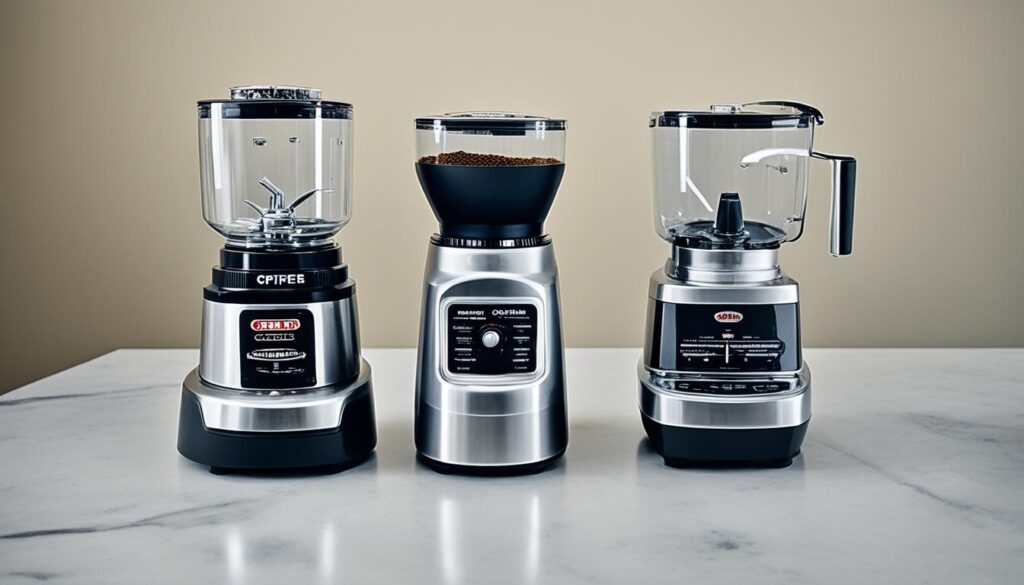
Ultimately, the choice between blade grinders and burr grinders will depend on your specific preferences and budget. If you’re looking for an affordable and versatile option, a blade grinder may be suitable. However, if you prioritize consistent grind sizes and maintaining the flavor of your coffee, investing in a burr grinder might be the better choice. Consider your needs and desired coffee quality to make an informed decision.
Recommended Coffee Bean Grinders
When it comes to grinding coffee beans, having the right grinder can make all the difference in achieving a perfect cup of coffee. Here are some of the best coffee bean grinders that we recommend:
- Baratza Virtuoso Conical Burr Coffee Grinder: This grinder offers consistent grind sizes, allowing you to dial in the perfect size for your preferred brewing method. Its conical burrs ensure a uniform grind, while the 40 grind settings give you full control over the grind. With its durable construction and user-friendly design, the Baratza Virtuoso is a top choice for coffee enthusiasts.
- Cuisinart DBM-8 Supreme Grind Automatic Burr Mill: Designed for convenience and versatility, this automatic burr grinder offers 18 grind settings, from ultra-fine to extra-coarse. It ensures a consistent grind size and features an automatic shut-off function for added safety. The Cuisinart DBM-8 is an affordable option that delivers reliable performance.
- Hario Transparent Black Mini Mill Plus: For those who prefer manual grinding, the Hario Transparent Black Mini Mill Plus is a compact and portable option. It features ceramic burrs that provide a consistent grind and an adjustable grind size setting. This grinder is perfect for travel or small kitchen spaces.
With these recommended coffee bean grinders, you can enjoy consistent grind sizes, control over the grind, and the preservation of the coffee’s flavor. Choosing the right grinder for you depends on your individual needs, preferences, and budget.
Investing in a high-quality coffee grinder is a worthwhile step towards brewing the best cup of coffee. Whether you prefer the convenience of an automatic burr grinder or the hands-on approach of a manual grinder, these recommended options will elevate your coffee experience. Experiment with different grind sizes, brewing methods, and coffee beans to find your perfect cup.
Conclusion
Grinding coffee beans to the right size for brewing is essential for achieving the perfect cup of coffee. By understanding the different coffee grind sizes and their corresponding brewing methods, we can tailor our brewing process to suit our taste preferences. Whether we prefer a strong, bold cup of coffee or a smooth, balanced one, choosing the right grind size is key.
Using the right grinder is equally important in the pursuit of brewing the best coffee. Burr grinders, such as the Baratza Virtuoso Conical Burr Coffee Grinder and Cuisinart DBM-8 Supreme Grind Automatic Burr Mill, offer consistent grind sizes and help preserve the flavor of the coffee. Investing in a quality grinder allows us to have more control over the grind and ultimately enhances our coffee brewing experience.
Properly storing coffee beans is another crucial factor in brewing a flavorful and satisfying cup of coffee. By keeping our coffee beans in an airtight container, away from heat, light, and moisture, we can maintain their freshness for a longer period. It’s best to buy coffee beans in small quantities and grind them just before brewing for the freshest taste and aroma.
Remember, experimenting with different grind sizes, brewing methods, and coffee bean origins can be an exciting journey that leads us to discover our own perfect cup of coffee. So let’s explore, refine our techniques, and savor the joy of brewing the best coffee, one cup at a time.
FAQ
What is the importance of grind size in coffee brewing?
The size of the coffee grind affects the flavor and strength of the coffee. A finer grind results in a stronger cup of coffee, while a coarser grind produces a weaker cup.
What are the recommended coffee grind sizes for different brewing methods?
French Press requires a coarse grind, drip coffee calls for a medium grind, pour over has a range from medium-coarse to medium-fine, espresso requires a fine grind, and cold brew benefits from an extra coarse grind.
What are the different types of coffee bean grinders?
There are blade grinders, which are more affordable but produce inconsistent grind sizes, and burr grinders, which offer consistent grind sizes and more control over the grind.
How should I store coffee beans?
Coffee beans should be stored in an airtight container, away from heat, light, and moisture.
What are the pros and cons of blade grinders and burr grinders?
Blade grinders are more affordable and versatile but produce inconsistent grind sizes. Burr grinders, on the other hand, produce consistent grind sizes but are more expensive and require more skill to use.
What are some recommended coffee bean grinders?
Some recommended coffee bean grinders include the Baratza Virtuoso Conical Burr Coffee Grinder, Cuisinart DBM-8 Supreme Grind Automatic Burr Mill, and Hario Transparent Black Mini Mill Plus.
How can I achieve the perfect cup of coffee?
By understanding the different coffee grind sizes, using the right grinder, and storing coffee beans properly, you can tailor your brewing process to your taste preferences.

